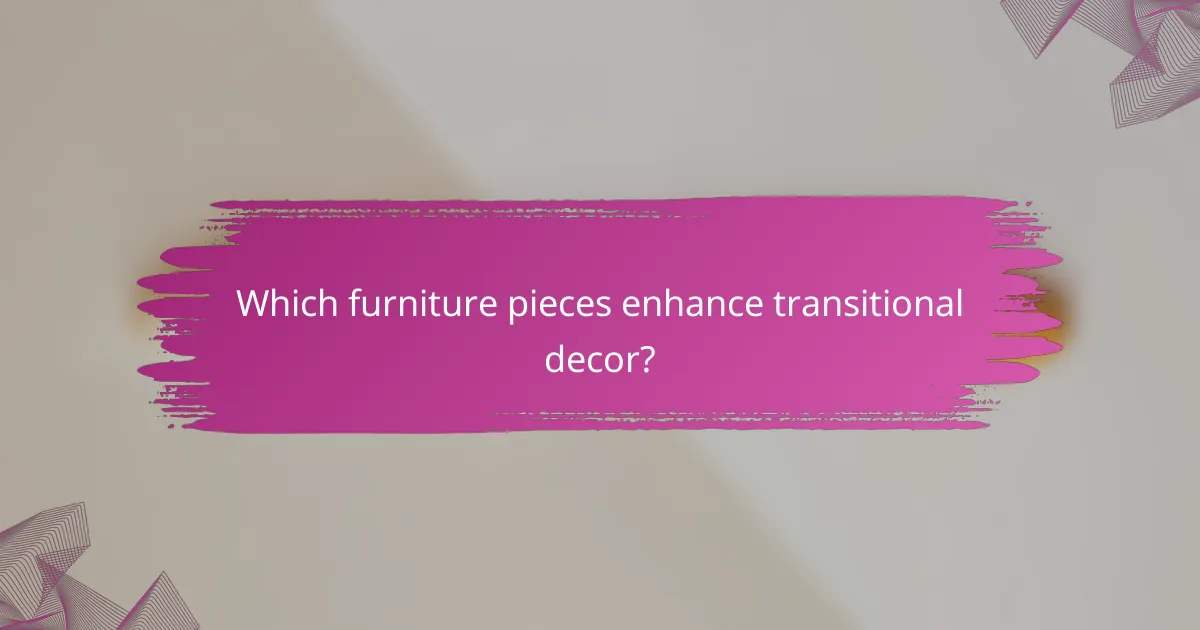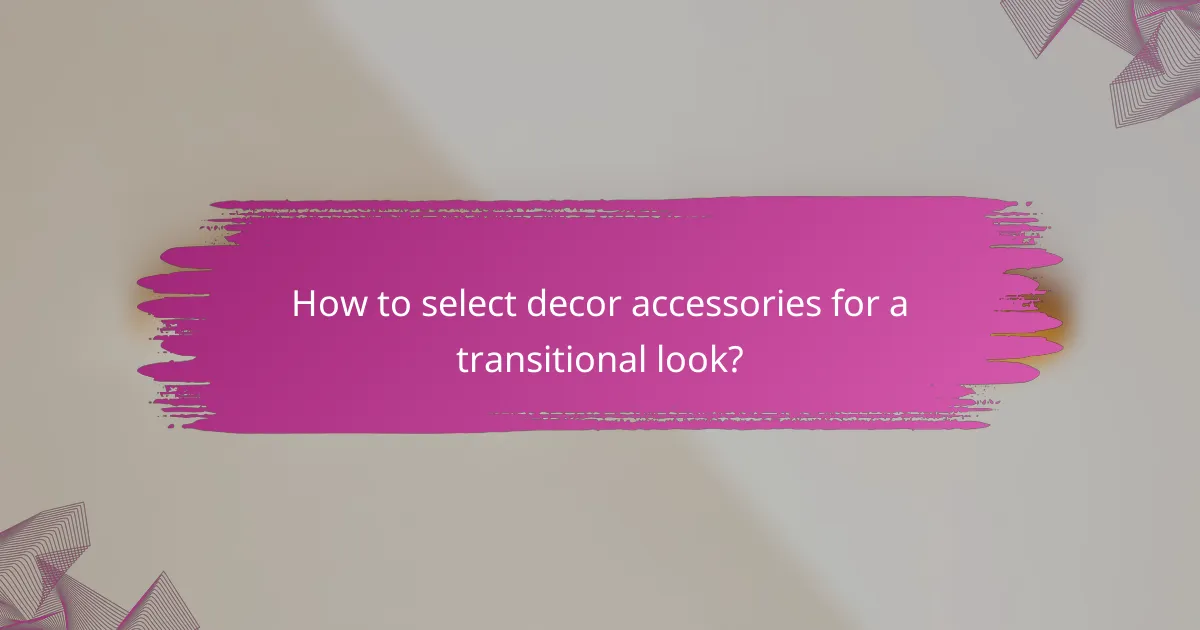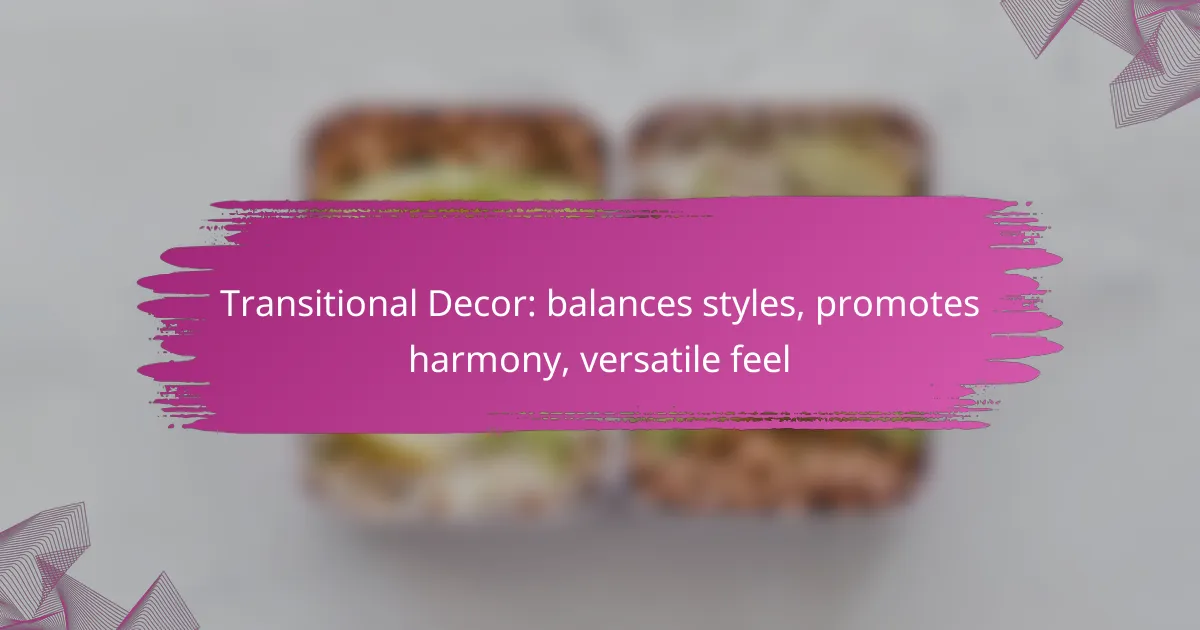Transitional decor seamlessly blends traditional and contemporary styles, creating a harmonious and inviting atmosphere in Canadian homes. This versatile design approach emphasizes balance and comfort, often featuring natural materials and neutral color palettes that suit a variety of spaces. By incorporating carefully selected furniture pieces, such as sectional sofas and wooden coffee tables, transitional decor enhances both elegance and functionality.

How to achieve harmony with transitional decor in Canadian homes
Achieving harmony with transitional decor in Canadian homes involves blending modern and traditional styles to create a cohesive and inviting atmosphere. This approach emphasizes balance, allowing for versatility in design while promoting a sense of comfort and elegance.
Mixing modern and traditional elements
To successfully mix modern and traditional elements, start by selecting key pieces from both styles that complement each other. For example, pair a contemporary sofa with a classic wooden coffee table to create a focal point that draws the eye.
Consider using modern art pieces alongside traditional furniture to create visual interest. This juxtaposition can enhance the overall aesthetic, making the space feel both timeless and current.
Using neutral color palettes
A neutral color palette is essential for achieving harmony in transitional decor. Opt for shades like beige, gray, and soft whites to create a calming backdrop that allows other design elements to shine.
Incorporate pops of color through accessories, such as throw pillows or artwork, while keeping the main colors subdued. This approach maintains a balanced look without overwhelming the senses.
Incorporating natural materials
Natural materials like wood, stone, and linen are key to enhancing the warmth and texture of transitional decor. Use hardwood flooring or stone countertops to establish a solid foundation that feels grounded and inviting.
Incorporate textiles such as cotton or wool for soft furnishings to add comfort. These materials not only contribute to the aesthetic but also promote a sense of harmony with nature, which is particularly appreciated in Canadian homes.

What are the best transitional decor styles for Canadian interiors?
The best transitional decor styles for Canadian interiors blend traditional and contemporary elements, creating a harmonious and versatile aesthetic. These styles often incorporate natural materials and neutral color palettes, making them suitable for various spaces.
Contemporary farmhouse
Contemporary farmhouse style combines rustic charm with modern design, making it a popular choice in Canadian homes. This style typically features open spaces, large windows, and a mix of wood and metal elements, promoting a warm yet sophisticated atmosphere.
Key characteristics include shiplap walls, reclaimed wood accents, and comfortable furnishings. To achieve this look, consider incorporating a neutral color scheme with pops of color through accessories like throw pillows or artwork.
Modern rustic
Modern rustic decor emphasizes simplicity and natural beauty, often using organic materials to create a cozy environment. This style blends sleek lines with earthy textures, resulting in a balanced aesthetic that feels both contemporary and grounded.
Common features include stone fireplaces, wooden beams, and minimalist furniture. To enhance this style, focus on layering textures, such as soft textiles and rough-hewn surfaces, while maintaining a cohesive color palette that reflects the natural surroundings.

Which furniture pieces enhance transitional decor?
Transitional decor blends traditional and contemporary styles, and specific furniture pieces can enhance this aesthetic. Key items include sectional sofas, wooden coffee tables, and accent chairs, each contributing to a harmonious and versatile feel.
Sectional sofas
Sectional sofas are ideal for transitional decor due to their adaptability and comfort. They can serve as a focal point while offering ample seating, making them perfect for both casual and formal gatherings. Look for designs that feature clean lines and a mix of fabrics to maintain a balanced look.
When selecting a sectional, consider neutral colors like gray or beige to complement various styles. Additionally, modular sectionals allow for rearrangement, providing flexibility as your decor evolves.
Wooden coffee tables
Wooden coffee tables add warmth and texture to transitional spaces. Opt for tables with a mix of finishes, such as reclaimed wood or a sleek veneer, to bridge the gap between traditional and modern styles. Round or rectangular shapes can work well, depending on your room layout.
Ensure the coffee table height is proportionate to your seating for comfort. A table with storage options can also enhance functionality, keeping the space organized while maintaining aesthetic appeal.
Accent chairs
Accent chairs are essential for adding personality to transitional decor. Choose chairs that feature a blend of classic and contemporary designs, such as a wingback chair with a modern fabric. These pieces can create visual interest and provide additional seating without overwhelming the space.
Consider using accent chairs in bold colors or patterns to create focal points within the room. Pairing them with neutral sofas and tables can help maintain a cohesive look while allowing for individual expression.

How to select decor accessories for a transitional look?
Selecting decor accessories for a transitional look involves blending traditional and contemporary elements to create a harmonious space. Focus on pieces that balance styles, ensuring they complement each other while promoting a versatile and cohesive feel.
Choosing artwork that blends styles
When selecting artwork for a transitional decor, aim for pieces that incorporate both classic and modern elements. Look for artworks that feature a mix of traditional subjects with contemporary techniques or abstract styles.
Consider using large-scale pieces that serve as focal points, or a gallery wall that combines various styles in a cohesive manner. This approach allows for personal expression while maintaining the transitional aesthetic.
Using layered textiles
Layering textiles is essential for achieving a transitional look. Combine different fabrics, such as a traditional wool throw with modern linen cushions, to create depth and interest in your space.
Incorporate a variety of textures and patterns, but keep a cohesive color palette to ensure harmony. For instance, use neutral base colors with pops of vibrant hues in your textiles to maintain balance while adding character.

What are the key color schemes for transitional decor?
Transitional decor often features a blend of traditional and contemporary styles, and its key color schemes reflect this balance. Soft earth tones and muted jewel tones are popular choices that promote harmony and versatility in various spaces.
Soft earth tones
Soft earth tones, such as beige, taupe, and warm grays, create a calming backdrop in transitional decor. These colors evoke a sense of nature and tranquility, making them ideal for living rooms and bedrooms where relaxation is key.
When incorporating soft earth tones, consider using them on larger surfaces like walls or furniture. Accents in darker shades can add depth, while lighter tones keep the space airy. For example, pairing a taupe sofa with cream pillows can enhance the overall warmth of the room.
Muted jewel tones
Muted jewel tones, including deep greens, rich blues, and soft burgundies, add a touch of sophistication to transitional decor. These colors can serve as focal points or accents, providing a subtle richness without overwhelming the space.
To effectively use muted jewel tones, select one or two as accent colors against a neutral backdrop. For instance, a deep green accent chair can stand out beautifully in a room dominated by soft earth tones. Be cautious not to overuse these colors, as they can easily dominate the decor if applied excessively.

How to balance functionality and aesthetics in transitional decor?
Balancing functionality and aesthetics in transitional decor involves blending modern and traditional elements to create a cohesive, harmonious space. Focus on selecting versatile pieces that serve multiple purposes while maintaining a visually appealing design.
Multi-purpose furniture
Multi-purpose furniture is essential in transitional decor, as it maximizes space and enhances functionality without sacrificing style. Look for items like ottomans that double as storage or coffee tables that can extend for dining purposes.
When choosing multi-purpose furniture, consider the size and scale of your space. For smaller areas, compact designs that can easily transform, such as a sofa bed or a foldable desk, are ideal. Aim for a balance between practicality and aesthetic appeal, ensuring that each piece complements the overall decor.
Common pitfalls include overcrowding a room with too many multifunctional items, which can lead to a cluttered look. Instead, select a few key pieces that serve distinct functions while contributing to the room’s visual harmony. Prioritize quality and design to ensure these items enhance both the functionality and aesthetics of your space.
